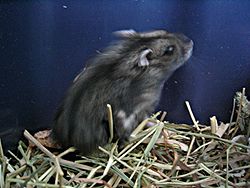AY Honors/Small Mammal Pets/Answer Key
Template:Taxobox Winter White Russian hamsters are a species of hamster in the genus Phodopus. They are typically half the size of the better-known Syrian hamster, and therefore called dwarf hamsters along with all Phodopus species. Features include a typically dark gray dorsal stripe and furry feet. The tail is so short that it hardly shows when the hamster is sitting. As winter approaches and the days get shorter, Winter Whites' dark fur greys until it is almost completely white (hence the name). In the wild, this adaptation helps them evade predators in the snow covered Steppes of winter. They live mainly in Siberia and are also found in Dzungaria, Kazakhstan, Mongolia and Manchuria.
Up until recently, it was debated whether the Winter White hamster was a sub-species of the Campbell's (Phodopus campbelli) or not; however, it has now been proven that the Winter whites are of their own species, Phodopus sungorus.
Winter White Russian hamsters as pets
They are often found on the pet market, in Europe and Asia more so than in the U.S.. They are rarely found in pet stores in Canada. Care is similar to that of the Campbell's hamster. Winter White hamsters generally make excellent pets. However, a larger Syrian hamster would be more suitable for younger children as they can be handled more clumsily. Winter White hamsters should not be fed food containing sources of monosaccharides because of the risk of developing diabetes mellitus.
Winter Whites, other than their close relatives, the Campbell's, often cannot be housed together in groups. Although quite some pet owners report that their winter white hamsters enjoy each others company, it is much more common that --after reaching sexual maturity--, they start fighting violently, causing serious injury to each other. Hence, it is usually (though not undisputedly) recommended to keep them solitary. Although if two females are introduced at a young age they will live happily together.
In general, dwarf hamsters typically have more of a family structure than the Syrian hamster. Dwarf hamsters will happily live in mated pairs, with both male and female caring for the young, but some report that same-sex pairs and larger groups will rarely get along well, as they wouldn't live together like that in nature. Frequent fighting may occur and be a great distress for them, or even lead to deadly incidents. This is in contrast to the Campbell's species and remains an item of dispute among hamster owners.
Winter White hamsters used to be only available in their typical brown/black "normal" color, but they are now available in a variety of colors. Colors include at least normal (dark gray/brown), pearl normal, sapphire and pearl sapphire variations. However, these colors may be difficult to find, and the number of available colors is much smaller than in the dwarf Campbell's hamster.
Winter White hamsters, also called Siberian hamsters, come from the steppes of Siberia and Kazakhstan and possess an adaptation not seen in Campbell's; they can moult into a white winter coat. This camouflages them against the snow and also gives them their name. This moulting is brought on by the amount of sunlight, if the hamster is kept in a dark environment, they will change into their "winter" coat. When in the winter coat, Winter Whites will become infertile.
External links
- Hamster Heaven
- Xander.it - Winter White video gallery
- PetWebSite pages on Winter Whites
- FurryCritters
de:Dsungarischer Zwerghamster es:Phodopus sungorus fr:Hamster russe it:Phodopus sungorus he:אוגר סיבירי nl:Russische dwerghamster ja:ジャンガリアンハムスター pl:Chomik dżungarski fi:Venäjänkääpiöhamsteri zh:短尾侏儒倉鼠

